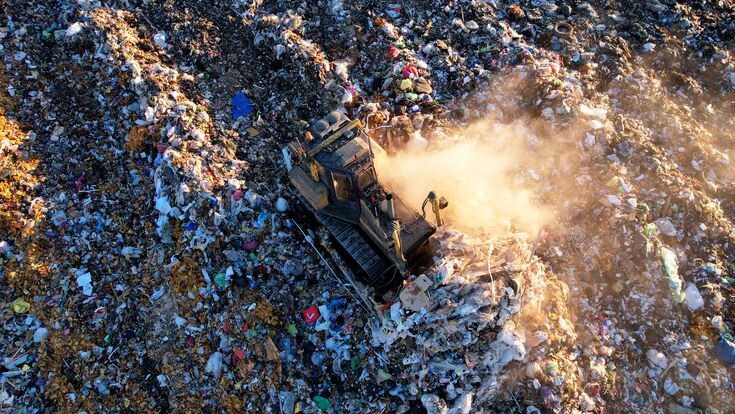GHG emissions : How much methane is generated by the global landfilling of urban wastes?

According to the World Bank, in 2020 the world generated 2.2 billion tons of waste, of which 40%2 were deposited in urban landfills. The biodegradable materials in landfills such as food waste and green waste, react with water to form methane and carbon dioxide. A simple equation to represent this bioreaction is:
C6H10O4 + 1.5H2O = 3.25CH4 + 2.75CO2
This equation projects that the landfill biogas, after some oxidation at the upper layers of a landfill contains about 50% of CH4, which is the usual experience at landfills. However, the big unknown in waste management is how much methane is generated from one ton of waste over the years that the waste stays in a landfill. The answer to this question depends on many factors, such as location, climatic conditions, waste composition, depth of landfill, etc., etc.
Estimating expected methane generation
I have been asked the above question many times and I decided to make a "leap of imagination", such as has been made many times in engineering, e.g., in the "invention" of the "friction factor" and its correlation to the dimensionless Reynolds Number. In this leap, I used calculations based on the chemistry of biodegradation combined with the operating experience of nearly four hundred landfills participating in the U.S.E.P.A. Landfill Methane Outreach Program (LMOP); they landfill about two hundred million tons of MSW. The objective of this exercise was to come up with a metric that can be used for estimating the expected generation of methane from landfills and the potential for the capture of methane. This study was conducted in collaboration with Prof. Thanos Bourtsalas of Columbia University and its results are available on the web. The metric we chose is "average methane generation” and is expressed as ton CH4 per ton of annual MSW deposition". Our first estimate, for all U.S. landfills, was 0.05 t CH4/t MSW, which is about 40% of the complete biodegradation of all biodegradable materials in the US MSW.
The first supportive data of this metric was provided by a detailed study of the US 396 LMOP landfills, using their reported daily landfill gas (LFG) capture and assuming that it applied to the 365-day operation of the LFG capture facilities. On this basis, the reported average capture of the LMOP landfills was 0.024 t CH4/t MSW. Also, the EPA 2023 GHGRP report, shows the 2018 generation of LFG to be 332.6 million metric tons, that is 0.06 t CH4/t MSW landfilled, which is 20% greater than our estimate of 0.05 t CH4.t MSW.
Based on the 0.06-ton generation (EPA) and our 0.024-ton capture of CH4, the average capture efficiency of the U.S. LMOP landfills is 0.024/0.06 = 40%. Because of the assumed 365-day operation, the actual capture efficiency of the 396 LMOP landfills is lower than 40%.
I am publishing this summary in Waste Management World to reach people in global waste management and encourage debate on the results of our study. Using the World Bank numbers for global landfilling and assuming that 0.05 tons of methane are generated per ton landfilled results in the estimate of 880 million tons landfilled and 44 million tons of methane generated. A small amount of it is captured in sanitary landfills, as in the case of U.S. LMOP landfills. The landfill methane emitted to the atmosphere is estimated to be equivalent to 900 million tons of carbon dioxide for a methane horizon of 100 years and three times as much for a 20-year horizon.
Contact the author at njt1@columbia.edu


